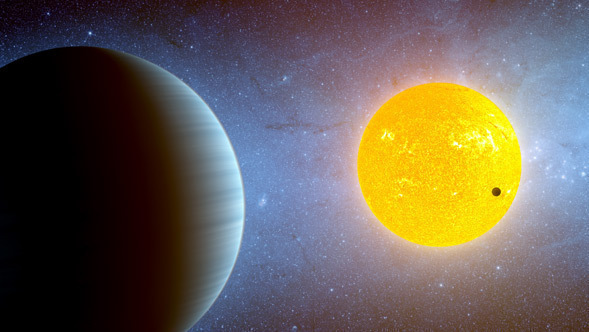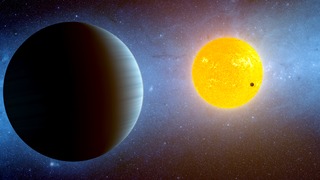
News Release • May 23rd, 2011 • feature11-03 •
A new planetary member of the Kepler-10 solar system was announced today. Using data from NASA's Spitzer Space Telescope, members of the Kepler science team confirmed a new planet, dubbed Kepler-10c.
The Kepler-10 star system is located about 560 light-years away near the Cygnus and Lyra constellations. The Kepler telescope has discovered two planets around this star. Kepler-10b is, to date, the smallest known rocky exoplanet, or planet outside our solar system (dark spot against yellow sun). This planet, which has a radius of 1.4 times that of Earth's, whips around its star every 0.8 days. Its discovery was announced in Jan. 2011.
Now, in May 2011, in a study led by Francois Fressin from the Harvard-Smithsonian Center for Astrophysics, the Kepler team is announcing another member of the Kepler-10 family, called Kepler-10c. It's bigger than Kepler-10b with a radius of 2.2 times that of Earth's, and it orbits the star every 45 days. Both planets would be blistering hot worlds.
Kepler-10c was first identified by Kepler, and later validated using a combination of a computer simulation technique called "Blender," and NASA's Spitzer Space Telescope. Both of these methods are powerful ways to validate the Kepler planets that are too small and faraway for ground-based telescopes to confirm using the radial-velocity technique. The Kepler team says that a large fraction of their discoveries will be validated with both of these methods.
In the case of Kepler-10c, scientists can be 99.998 percent sure that the signal they detected is from an orbiting planet. Part of this confidence comes from the fact that Spitzer, an infrared observatory, saw a signal similar to what Kepler detected in visible light. If the signal were coming from something other than an orbiting planet -- for example an indistinguishable background pair of orbiting stars -- then scientists would expect to see different signals in visible and infrared light.





